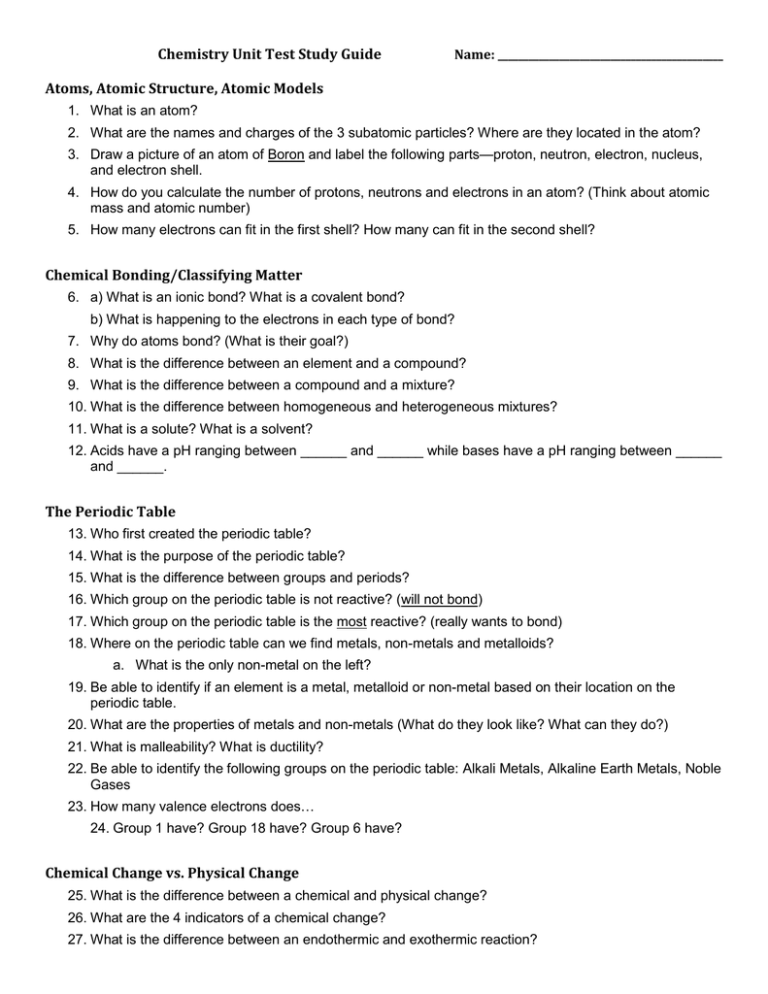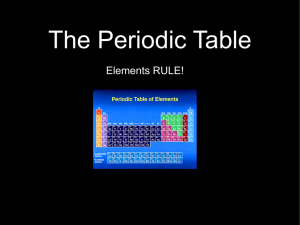Chemistry Unit Test Study Guide Atoms, Atomic Structure, Atomic Models
advertisement

Chemistry Unit Test Study Guide Name: ____________________________________________ Atoms, Atomic Structure, Atomic Models 1. What is an atom? 2. What are the names and charges of the 3 subatomic particles? Where are they located in the atom? 3. Draw a picture of an atom of Boron and label the following parts—proton, neutron, electron, nucleus, and electron shell. 4. How do you calculate the number of protons, neutrons and electrons in an atom? (Think about atomic mass and atomic number) 5. How many electrons can fit in the first shell? How many can fit in the second shell? Chemical Bonding/Classifying Matter 6. a) What is an ionic bond? What is a covalent bond? b) What is happening to the electrons in each type of bond? 7. Why do atoms bond? (What is their goal?) 8. What is the difference between an element and a compound? 9. What is the difference between a compound and a mixture? 10. What is the difference between homogeneous and heterogeneous mixtures? 11. What is a solute? What is a solvent? 12. Acids have a pH ranging between ______ and ______ while bases have a pH ranging between ______ and ______. The Periodic Table 13. Who first created the periodic table? 14. What is the purpose of the periodic table? 15. What is the difference between groups and periods? 16. Which group on the periodic table is not reactive? (will not bond) 17. Which group on the periodic table is the most reactive? (really wants to bond) 18. Where on the periodic table can we find metals, non-metals and metalloids? a. What is the only non-metal on the left? 19. Be able to identify if an element is a metal, metalloid or non-metal based on their location on the periodic table. 20. What are the properties of metals and non-metals (What do they look like? What can they do?) 21. What is malleability? What is ductility? 22. Be able to identify the following groups on the periodic table: Alkali Metals, Alkaline Earth Metals, Noble Gases 23. How many valence electrons does… 24. Group 1 have? Group 18 have? Group 6 have? Chemical Change vs. Physical Change 25. What is the difference between a chemical and physical change? 26. What are the 4 indicators of a chemical change? 27. What is the difference between an endothermic and exothermic reaction? Chemical Equations 28. Be able to label the following parts of a chemical equation—reactants, products, coefficients, and subscripts. Practice on the following equation: a. 2 H2O 2 H2 + O2 b. Is this equation synthesis, decomposition or single replacement? 29. What is the Law of Conservation of Mass? 30. If the mass of the reactants in an equation is 158g, what is the mass of the products? 31. Name the atoms in the following compounds and tell how many atoms of each element are in each compound: a. H3CO2 b. Ca2SO4 c. NaOH 32. What is our goal when balancing a chemical equation? (How do we know we’re balanced?) 33. What is the difference between a catalyst and an inhibitor? Balancing Equations Practice: One of these equations will be on your test. _____Fe + _____O2 _____Fe2O3 _____ K + _____ Br2 _____KBr _____ Zn + _____HCl _____ ZnCl2 + _____H2 _____Na + _____ H2O _____NaOH + ______H2 _____ S8 + _____ O2 _____SO3 _____N2 + _____ H2 _____NH3






